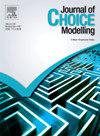Quantifying the value of carbon label information in food choice using drift diffusion modelling
IF 2.4
3区 经济学
Q1 ECONOMICS
引用次数: 0
Abstract
The use of carbon labels as an intervention to increase more sustainable food consumption has seen many mixed results, with some studies showing that consumers do not utilise the carbon labels in their decisions. To address the mixed results in the literature, we present a novel and in-depth evaluation of how carbon labels work by quantifying the importance of carbon label information relative to taste preferences in food decisions via a computational modelling approach. Participants (n = 48) were presented with multiple trials of two sandwiches alongside their carbon labels. Participants' choice and response time were recorded whilst visual attention was tracked with an eye-tracking device. The Multi-attribute Attentional Drift Diffusion Model (maaDDM) was fitted to data through Bayesian STAN modelling in R. The analysis revealed that carbon labels were used to a moderate extent similar to individual taste preference in choosing sandwiches, but the extent of use varied as a function of participant's perception of the negative impact of GHG emissions (the more negative perception, the greater use of carbon labels). We further explore the insights gained from maaDDM on participant's information sampling behaviour, and discuss the implications for policies to identify a critical valuation threshold of carbon labels.
用漂移扩散模型量化碳标签信息在食品选择中的价值
使用碳标签作为一种干预措施来增加更可持续的食品消费已经看到了许多不同的结果,一些研究表明,消费者在他们的决定中并不使用碳标签。为了解决文献中的混合结果,我们通过计算建模方法量化碳标签信息相对于食物决策中口味偏好的重要性,提出了一种新颖而深入的碳标签如何工作的评估。参与者(n = 48)多次尝试两种三明治,并附上碳标签。参与者的选择和反应时间被记录下来,同时用眼球追踪设备追踪视觉注意力。多属性注意力漂移扩散模型(maaDDM)通过贝叶斯STAN模型在r中拟合数据。分析表明,碳标签在选择三明治时的使用程度中等,类似于个人口味偏好,但使用程度随参与者对温室气体排放负面影响的感知而变化(越负面的感知,碳标签的使用越多)。我们进一步探讨了从maaDDM中获得的关于参与者信息采样行为的见解,并讨论了确定碳标签关键估值阈值的政策含义。
本文章由计算机程序翻译,如有差异,请以英文原文为准。
求助全文
约1分钟内获得全文
求助全文

 求助内容:
求助内容: 应助结果提醒方式:
应助结果提醒方式:


